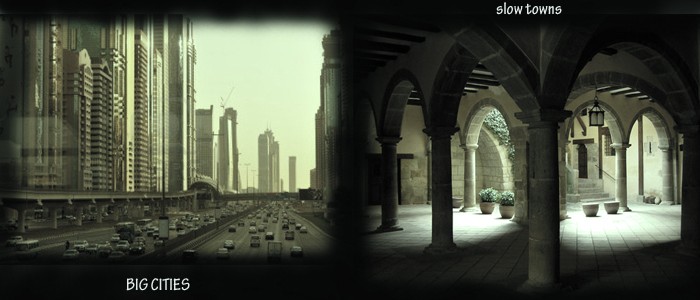Since 1986 Carlo Pretini promulgates slow down the rhythm of life. It considers the possibility of living enjoying slow food cooked step by step as it is typical in the Italian culture. He is the prime mover of the slow food movement, which has been the lead to other similar movements as Slow Movement, Slow Living, Slow Travel, Slow Design or Slow Cities.
Slow City, Cittaslow o Ciudades Lentas is a movement that emerge in the nineties in Italy. It has been extended worldwide, and now it´s in almost 30 countries.
If a city wants to be a member of the community, it should obey the requirements that guarantee this lifestyle. Also, they have to pay, depending on the category they are: Town Cittaslow (less than 50.000 inhab). Follower Cittaslow (more de 50.000 inhab.), or Friend Cittaslow ( people that promulgate slow principles).
Cittalow philosophy consists on living quietly. They recover memory in a globalize world because the real important thing is to avoid social desertification. They are against loosing family life in town instead of living in big cities. They give priority to real basic topics, which are based on cooperation and solidarity into the community.
We find already people in big cities that decide to give stress up to small town quietness. Metropolis are becoming bigger, they are loosing its identity. All happens so fast, people feel they are lost. Facing this liberty lost, small towns offer a contemplative life, where people can canalize personal and familiar objectives, enjoying life next to nature.
This movement has the headquarter in Orvieto (Italy)(www.cityslow.org). You will find a small place, but with a big history. All visitors, will enjoy the pleasure of simplicity. They are an example of respect of the local cultural asset and environmental.
Manuel Ludueña, architect that collaborated in the strategic plan of Balcarce, says that Slow is a cultural demonstration nearby sustainability. People feel like taking part of a social group where they value natural goods.
These cities are typical because you don´t find noises, movement is unhurried, relaxed conversations, streets without concrete, visible fonts, occasional cars, agriculture and fauna are part of the city, artisan are important, infrastructure is basic, and all belong to the community.
In a big city it is very difficult to slow down. These inventors are working in a project that wants to apply the model in districts in cities as Barcelona, Brussels or Vienna. This approach is for the people follow the slow principles in the cities.
Source: ecoportal.net, Por Guillermo Tella y Martín M. Muñoz



